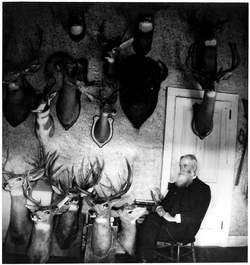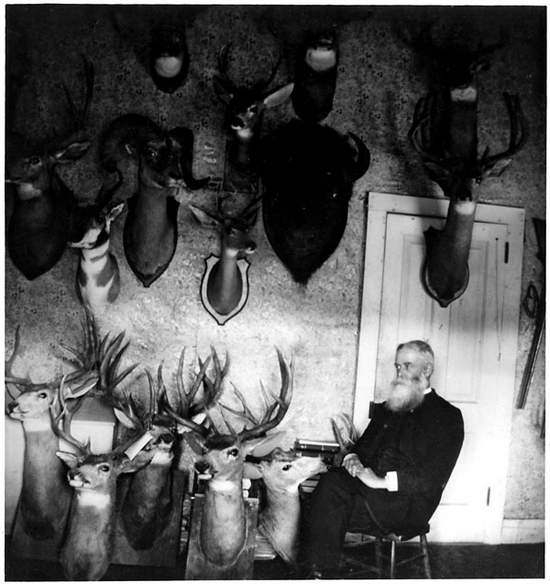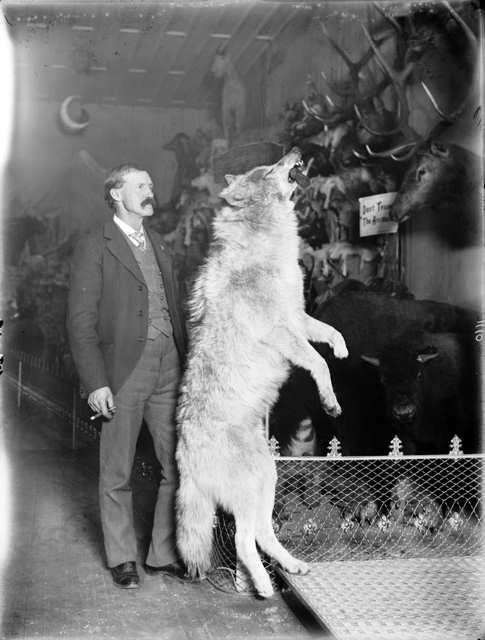Edwin Carter, known as "Professor" and "the log cabin naturalist," amassed a collection of some 3300 specimens of Colorado wildlife for his private museum in the old mining town of Breckenridge. His offer to sell the collection to a museum that would care for it was the spark that ignited the founding in 1900 of the Colorado Museum of Natural History, the original name of the Denver Museum of Nature & Science.
Edwin Carter was born in 1828 in Oneida, New York. As a young man he moved to Iowa and worked as a merchant. In 1859 he joined the "Pike's Peak or Bust" gold rush to Colorado and became a successful placer miner, recovering loose nuggets from stream beds. He first went to Russell Gulch in Central City but found little room to prospect. He moved on to Summit County and in 1860 made one of the best early placer discoveries in that area. He acquired additional properties around the town of Breckenridge that later provided good income as gold mining was developed on them. In 1868 he purchased property in downtown Breckenridge where he would later settle.
But first Carter moved to Black Hawk to learn taxidermy and the handling and preservation of bird and animal hides. While traveling around the mining areas he had noticed a decline in the numbers and the quality of wildlife in central Colorado. He surmised that mining, logging, and chemical treatment of ores were having a deleterious effect on the birds and animals so plentiful when he first arrived. Carter decided to dedicate his life to collecting and preserving as many species and types of abnormal specimens as he could find. He returned to Breckenridge in 1872 and in 1875 opened a large log structure. This served as his home, workroom, and a museum containing hundreds of specimens from large bison, bears, and elk to small birds. As his collection grew, the Carter wildlife museum became famous. Carter never charged admission and enjoyed telling every visitor, from local children to naturalists from around the world, about what he was learning from his hobby.
Carter did not marry and had no relatives in Colorado. Concerned about the future of his many specimens, he approached some prominent citizens of Denver in 1897 about establishing a museum to house and care for his collection. With this impetus, the group studied the proposal, secured funding, and on December 6, 1900, the Colorado Museum of Natural History was incorporated. But Professor Carter did not live to witness this important event. In poor health, he traveled south in January 1900, hoping the warmth and low altitude would help him regain strength. A month later he died in a rest home in Galveston, Texas. His body was returned to Breckenridge and buried there.
Edwin Carter, known as "Professor" and "the log cabin naturalist," amassed a collection of some 3300 specimens of Colorado wildlife for his private museum in the old mining town of Breckenridge. His offer to sell the collection to a museum that would care for it was the spark that ignited the founding in 1900 of the Colorado Museum of Natural History, the original name of the Denver Museum of Nature & Science.
Edwin Carter was born in 1828 in Oneida, New York. As a young man he moved to Iowa and worked as a merchant. In 1859 he joined the "Pike's Peak or Bust" gold rush to Colorado and became a successful placer miner, recovering loose nuggets from stream beds. He first went to Russell Gulch in Central City but found little room to prospect. He moved on to Summit County and in 1860 made one of the best early placer discoveries in that area. He acquired additional properties around the town of Breckenridge that later provided good income as gold mining was developed on them. In 1868 he purchased property in downtown Breckenridge where he would later settle.
But first Carter moved to Black Hawk to learn taxidermy and the handling and preservation of bird and animal hides. While traveling around the mining areas he had noticed a decline in the numbers and the quality of wildlife in central Colorado. He surmised that mining, logging, and chemical treatment of ores were having a deleterious effect on the birds and animals so plentiful when he first arrived. Carter decided to dedicate his life to collecting and preserving as many species and types of abnormal specimens as he could find. He returned to Breckenridge in 1872 and in 1875 opened a large log structure. This served as his home, workroom, and a museum containing hundreds of specimens from large bison, bears, and elk to small birds. As his collection grew, the Carter wildlife museum became famous. Carter never charged admission and enjoyed telling every visitor, from local children to naturalists from around the world, about what he was learning from his hobby.
Carter did not marry and had no relatives in Colorado. Concerned about the future of his many specimens, he approached some prominent citizens of Denver in 1897 about establishing a museum to house and care for his collection. With this impetus, the group studied the proposal, secured funding, and on December 6, 1900, the Colorado Museum of Natural History was incorporated. But Professor Carter did not live to witness this important event. In poor health, he traveled south in January 1900, hoping the warmth and low altitude would help him regain strength. A month later he died in a rest home in Galveston, Texas. His body was returned to Breckenridge and buried there.
Inscription
Founder of Carter's Museum
Sponsored by Ancestry
Advertisement
Explore more
Sponsored by Ancestry
Advertisement




